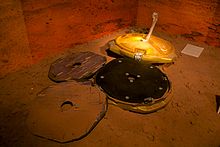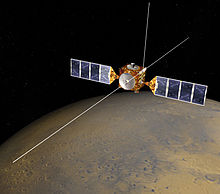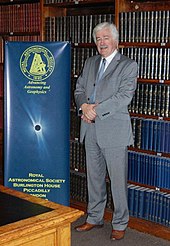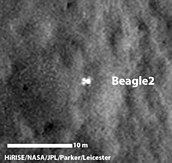Beagle 2
This articleneeds additional citations forverification.(March 2022) |
 Replica of theBeagle 2at theScience Museum,London | |
| Mission type | Mars lander |
|---|---|
| Operator | National Space Centre |
| COSPAR ID | 2003-022C[1] |
| Mission duration | 6 months (planned)[2] |
| Spacecraft properties | |
| Landing mass | 33.2 kg (73 lb) |
| Payload mass | 9 kg (20 lb) science instruments |
| Dimensions | Folded: 1 m diameter Unfolded: 1.9 m diameter Height: 12 cm[3] |
| Power | 60 W[3] |
| Start of mission | |
| Launch date | 2 June 2003, 07:45UTC |
| Rocket | Soyuz-FG/Fregat |
| Launch site | Baikonur Cosmodrome |
| Contractor | EADS Astrium |
| Deployed from | Mars Express |
| Deployment date | December 19, 2003 |
| End of mission | |
| Declared | February 6th, 2004 |
| Marslander | |
| Landing date | 25 December 2003, 02:45 UTC |
| Landing site | Isidis Planitia,Mars 11°31′44″N90°25′53″E/ 11.52879°N 90.43139°E[4] |
TheBeagle 2is an inoperative BritishMars landerthat was transported by theEuropean Space Agency's 2003Mars Expressmission. It was intended to conduct anastrobiologymission that would have looked for evidence of pastlifeon Mars.
The spacecraft was successfully deployed from theMars Expresson 19 December 2003 and was scheduled to land on the surface of Mars on 25 December. ESA, however, received no communication from the lander at its expected landing time on Mars, and declared the mission lost in February 2004 after numerous attempts to contact the spacecraft were made.[5]
TheBeagle 2'sfate remained a mystery until January 2015, when it was located on the surface of Mars in a series of images fromNASA'sMars Reconnaissance OrbiterHiRISEcamera.[6][7]The images showed it landed safely but two of its foursolar panelsfailed to deploy, blocking the spacecraft's communications antenna.
TheBeagle 2is named afterHMSBeagle,the ship that took the naturalistCharles Darwinon his round-the-world voyage.
Background[edit]

Beagle 2was conceived by a group of British academics headed by ProfessorColin Pillingerof theOpen Universityin collaboration with theUniversity of Leicester.The project was designed and developed by several UK academics and companies.[8]The spacecraft's name reflects its goal of searching for signs of past or presentlife on Mars.[9]According to Pillinger:
"HMSBeaglewas the ship that took [Charles] Darwin on his voyage around the world in the 1830s and led to our knowledge about life on Earth making a real quantum leap. We hopeBeagle 2will do the same thing for life on Mars. "[citation needed]
A 50 by 8 kilometres (31.1 by 5.0 mi) ellipse centered on11°32′N90°30′E/ 11.53°N 90.50°EatIsidis Planitia,an enormous, flat,sedimentary basinthat overlies the boundary between the ancient highlands and the northern plains of Mars, was chosen as the landing site.[9]The lander was expected to operate for about 180 days and an extended mission of up to oneMartian year(687Earthdays) was thought possible. TheBeagle 2lander's objectives were to characterise the landing sitegeology,mineralogy,geochemistry,andoxidation stateof the physical properties of theatmosphereand surface layers; collect data on Martianmeteorologyandclimate;and search forbiosignatures.
The principal investigator, Colin Pillinger, set up a consortium to design and buildBeagle 2.The principal members and their initial responsibilities were:[10]
- Open University– Consortium leader & scientific experiments
- University of Leicester– Project management, Mission management, Flight Operations Team, instrument management, and scientific experiments

Colin Pillinger,leader of theBeagle 2project, pictured in 2009 - Astrium– Main industrial partner
- Martin-Baker– Entry, descent and landing system
- Logica– Cruise, entry, descent and landing software
- SCISYS–Ground segmentand lander software
- University of Wales, Aberystwyth– Robotic arm
- McLaren Applied Technologies- composite materials for the solar panels[11]
Astriumtook over responsibility for program management, and Leicester assumed responsibility for mission management which involved the preparations for the operations post launch and the operations control centre.[citation needed]
In an effort to publicise the project and gain financial support, its designers sought and received the endorsement and participation of British artists. The mission's call-sign was composed by the bandBlur,[12]and the 'test card' (Calibration Target Plate) intended for calibratingBeagle 2'scameras and spectrometers after landing was painted byDamien Hirst.[citation needed]
The Lander Operations Control Center (LOCC), from which the spacecraft was to be controlled, was located at theNational Space CentreinLeicesterand was visible to the public visiting the centre. The control centre included operational systems for controllingBeagle 2,analysis tools for processing engineering and scientific telemetry, virtual reality tools for preparing activity sequences, communications systems, and the Ground Test Model (GTM). The GTM was composed of builds of theBeagle 2systems, collected together to provide a full set of lander electronics. The GTM was used nearly continuously to validate the engineering and science commands, rehearse the landing sequence, and validate the onboard software.[13]
Funding[edit]
The Beagle 2 lander was funded through a partnership arrangement involving the Open University, EADS-Astrium, the DTI, the Particle Physics and Astronomy Research Council (PPARC), the Office of Science and Technology and ESA. Funding also came from the National Space Science Centre and the Wellcome Foundation. UK principal investigators for Beagle 2 came from the Open University (gas analysis package), Leicester University (environmental sensors and x-ray spectrometer) and Mullard Space Science Laboratory (imaging systems).
— ESA[14]
The budget is secret but was estimated to be between£30 and 50 millionin 2004, which at then-currency exchange rates would be about€43-71 millionorUS$54−89 million.[15]New Scientistmagazine reported a budget of£40 millionforBeagle 2,[16]and another outlet said£50 million.[5]Some of the work is known to have been donated or done at-cost.[5]
Spacecraft and subsystems[edit]

This sectionneeds additional citations forverification.(June 2020) |
Robotic arm and analysers[edit]
Beagle 2has a robotic arm known as the Payload Adjustable Workbench (PAW) that was designed to be extended after landing. The arm is 109 cm (43 in) long when fully extended, and it can reach about 70 cm (28 in) to the nearest rocks. The PAW contains a pair ofstereoscopiccameras, a microscope with a 6-micrometreresolution, aMössbauer spectrometer,anX-ray spectrometer,a drill for collecting rock samples and a spot lamp.
Rock samples were to be passed by the PAW into amass spectrometerandgas chromatographin the body of the lander. The Gas Analysis Package (GAP) was to measure the relative proportions ofisotopes of carbonandmethane.Since carbon is thought to be the basis of all life, these readings could have revealed whether the samples contained the remnants of living organisms. Atmospheric methane is another signature of existing life, although geological processes can also be a source.
PLUTO[edit]
Beagle 2is equipped with a small sample retrieval tool named Planetary Undersurface Tool or PLUTO (nicknamed the mole), which would have been deployed by the robotic arm. PLUTO has a compressed spring mechanism that was designed to enable it to move across the surface at a rate of 20 mm per second and to burrow into the ground, collecting a subsurface sample in a cavity in its tip. PLUTO is attached to the lander by a 3-metre (9.8 ft) power cable that could be used as a winch to bring the sample back to the lander. It had the capability to burrow to depths of 1.5 metres (4.9 ft).[3]
Specifications[edit]
The lander is shaped like a shallow bowl with a diameter of 1 m (39.4 in) and a depth of 0.25 m (9.8 in). The lander's cover is hinged and folded open to reveal the craft's interior, which holds aUHFantenna, the 0.75 m (2.5 ft) long robotic arm, and the scientific equipment. The main body also contains the battery, telecommunications, electronics, central processor, heaters, additional payload items, and radiation and oxidation sensors. The lid itself should have unfolded to expose four disk-shapedsolar arrays.The lander package, including heat shield, parachutes, and airbags, had a mass of 69 kg (152 lb) at launch but the lander was only 33.2 kg (73 lb) at touchdown.
The ground segment[clarification needed]was derived from the European Space Agency software kernel known as SCOS2000. In keeping with the low cost of the mission, the control software was the first of its type designed on a laptop computer.[citation needed]
Mission profile[edit]
This sectionneeds additional citations forverification.(December 2016) |


Mars Expresswas launched fromBaikonuron 2 June 2003[12]at 17:45UTC.Beagle 2was initially mounted on the top deck of theEuropean Space Agency'sMars Expressorbiter.[12]It was released from the orbiter on a ballistic trajectory towards Mars on 19 December 2003.Beagle 2coasted for six days after release andentered the Martian atmosphereat about 20,000 km/h (12,000 mph). Its expected landing was on 2:54 UT on 25 December. The lander was protected from the heat of entry by aheat shieldcoated with NORCOAT, an ablating material made byEADS.Compression of the Martian atmosphere and radiation from the hot gas are estimated to have led to a peak heating rate of around 100W/cm2.
After deceleration in the Martian atmosphere, parachutes deployed and at about 200 metres (660 ft) above the surface, large airbags inflated around the lander to protect it when it hit the surface. Landing occurred at about 02:45 UTC on 25 December 2003.
After analysis of the imagery obtained in 2015, it has been conjectured after landing, the bags deflated and the top of the lander opened. These images suggest at most only two of the four solar panels were deployed. A signal was supposed to be sent toMars Expressafter landing and another the next (local) morning to confirmBeagle 2survived the landing and the first night on Mars. A panoramic image of the landing area was then supposed to be taken using the stereo camera and a pop-up mirror, after which the lander arm would have been released. The lander arm was to dig up samples to be deposited in the instruments for study, and the "mole" would have been deployed, crawling across the surface to a distance of about 3 metres (9.8 ft) from the lander and burrowing under rocks to collect soil samples for analysis.
The British government spent more than£22 million(US$40 million) onBeagle 2,with the remainder of the total£44 million(US$80 million) coming from the private sector.[18]
Mission failure[edit]
Although theBeagle 2craft successfully deployed from theMars Express,confirmation of a successful landing was not forthcoming. It should have come on 25 December 2003 whenBeagle 2was to have contactedNASA's2001 Mars Odysseyspacecraft. In the following days, the Lovell Telescope atJodrell Bankfailed to pick up a signal fromBeagle 2.The team said they were "still hopeful" of finding a successful return signal.
Attempts were made throughout January and February 2004 to contactBeagle 2usingMars Express.The first of these occurred on 7 January 2004. Although regular calls were made, hope was placed on communication occurring on 12 January, whenBeagle 2was pre-programmed to expect theMars Expressprobe to fly overhead, and on 2 February, when the probe was supposed to resort to the last communication back-up mode, Auto-transmit. No communication was ever established withBeagle 2,which was declared lost on 6 February 2004 by theBeagle 2Management Board. On 11 February, the ESA announced an inquiry into the failure ofBeagle 2would be held.[14]The board of inquiry was unable to find concrete reasons for the probe's failure and listed plausible reasons on the report they released on 24 August 2004.[12]
On 20 December 2005, Pillinger released specially processed images from theMars Global Surveyorthat suggestedBeagle 2had landed in a crater at the landing site on Isidis Planitia.[19]It was claimed the blurry images showed the primary impact site as a dark patch and, a short distance away,Beagle 2surrounded by the deflated airbags and with its solar panels extended.[20]Mars Reconnaissance Orbiter'sHiRISE camera imaged the area in February 2007 and revealed the crater was empty.[21]
Pillinger speculated[22]higher than expected levels of dust in the Martian atmosphere, which captures heat, caused it to expand and reduce in density so the parachutes were not able to sufficiently slow the probe's descent. This would cause the landing to be too hard, damaging or destroying the probe. A number of other failure hypotheses were produced at the time.[23]If the Martian atmosphere was thinner than expected, the parachute's effectiveness would be reduced and therefore cause the lander to hit the surface with enough speed to destroy it.[23]Turbulence in the atmosphere, which would affect the parachute, was also examined.[23]
Failures in missions to Mars are common. As of 2010, of 38 launch attempts to reach the planet, only 19 had succeeded.[citation needed]Failures are sometimes informally called theMars Curse.[24]
ESA/UK inquiry report[edit]
This sectionneeds additional citations forverification.(March 2022) |

In May 2004, the report from the Commission of Inquiry onBeagle 2was submitted to ESA and the UK's science ministerLord Sainsbury.[25]Initially the full report was not published on the grounds of confidentiality but a list of 19 recommendations was announced to the public.
David Southwood,ESA's Director of Science, provided four scenarios of possible failures:[26]
- Beagle 2entered in atmospheric conditions outside the range assumed by its designers and could have burnt up. The scenario it may have "bounced off into space" was put forward but this does not stand up to close technical scrutiny. The amount of dust in the atmosphere often widely varies, changing its density and temperature characteristics. The chosen margins on the design of the heat shield and the thermal loads it can withstand mean the burn-up scenario is unlikely given the steep entry-flight-path angle, the craft could conceivably have left the atmosphere again.[a]
- Beagle 2'sparachute or cushioning airbags failed to deploy or deployed at the wrong time. This is supported by the observation throughout the transfer to Mars, the out-gassing of some substance and subsequent condensation on optical components of theMars Expressspacecraft carrying theBeagle 2lander was observed. This observation would be consistent with a leak in the gas generators ofBeagle 2'sairbags;
- Beagle 2'sbackshell tangled with the parachute, preventing it from opening properly. It is not clear whether the difference in air drag between the probe with the parachute deployed and the back shell of the heat shield is sufficient to guarantee a safe separation distance[b];
- Beagle 2became wrapped up in its airbags or parachute on the surface and could not open. Entanglement with the parachute appears plausible because the parachute's strop was shortened from the original design to save mass. Assuming the airbags deployed,Beagle 2would have bounced off the surface into the descending parachute.[c]
In addition, further scenarios appeared plausible and consistent with the available body of data:
- Beagle 2may have jettisoned its airbags before it had come to a complete rest on the surface. For mass and cost reasons, the airbag-jettison device was designed to be triggered by a timer rather than by acceleration sensors that would have discerned when the lander package had stopped moving. Because the landing package of NASA'sSpirit rovermission rebounded off the surface in Gusev crater numerous times before coming to a standstill—taking much more time than anticipated—Beagle 2'stimer may have been set to a too-short time[d];
- The parachute deployment sequence was designed to be triggered by three accelerometers. The system was not designed for a "best out of three" logic but the first accelerometer was designed to compute a safe deployment velocity had been reached; this would trigger the parachute deployment sequence, even if the accelerometer readout was faulty.
In February 2005, following comments from theHouse of CommonsSelect committeeon science and technology, the report was made public and Leicester University independently published a detailed mission report, including possible failure modes and a "lessons learned".[27]
All above hypotheses were disproved in 2015 after theMars Reconnaissance Orbiterphotographed the remains of the lander: pictures show the probe landed safely and started its operations, deploying some of the solar panels before an on-ground failure prevented the full deployment of all panels; this prevented the onboard antenna, hidden under the last solar panel, from gaining visibility to any orbiter, making any form of communication with the lander impossible and leading to mission loss. This status is detailed below.
Discovery of location[edit]
The location ofBeagle 2on Mars was unknown from late 2003 to early 2015. On 16 January 2015, more than eleven years after its loss and eight months after Colin Pillinger died,[28]news sources confirmedNASA'sMars Reconnaissance Orbiterhad located the lander,[6][7][29]which is lying on the surface ofIsidis Planitiaat11°31′44″N90°25′53″E/ 11.52879°N 90.43139°E,[4][30][31]about 5 km (3.1 mi) from the planned centre of its landing zone.[8]
On 26 April 2016, new computer vision methods stacked multiple new images together to create a view of the lander.[32]The technique calledSuper-Resolution Restoration(SRR) allows improvement in resolution by taking multiple views then intensively processing them.[33]At the time, it took up to four days on the fastest-available computers to compute one improved image from five 1,000-by-2,000-pixel images.[33]
Lander status[edit]
Imaging analysis appears to show the probe on the surface and partially deployed, in the expected landing area, with objects that have been interpreted as being its parachute and back cover nearby. Although several interpretations of the image are possible, all involve incomplete deployment of the probe's solar panels. Images suggest one of the "petals" on which the solar panels of the lander are mounted failed to fully open, preventing deployment of its radio antenna and blocking communication.[6][7][29][34]As the probe's antenna is beneath the last panel, it would have been unable to transmit or receive in such a configuration so the lander would have been beyond recovery even if its systems were still operational. Possible failure scenarios include mechanical damage during landing, fouling of the deployment mechanism and obstruction of the panels by an airbag.
Eleven years after the landing, ESA said;[5]"Beagle 2made it to the surface. This vindicates the engineering team's approach to landing on Mars. "[5]At a news conference in London, the UKSA noted; "Beagle 2is no longer lost ".[35]In reviews of lost Mars missions,Beagle 2and its rediscovery are typically noted.[36]
AfterBeagle 2was found, apparently intact and with some solar panels deployed, the events following its landing were re-evaluated.[5]Because the early phase of mission ran on chemicalbattery power,it is possible the lander's Solid State Mass Memory (SSMM) recorded some data, even if it could not obtain full power from its solar panels.[5]It might eventually be possible to retrieve the data.[5][37]A study has revealedBeagle 2may have gone into its pre-programmed surface operations mode and collected data after landing but did not transmit it or the transmission was blocked by a closed panel.[37][38]
Follow-on mission proposals[edit]
Further use of some features of theBeagle 2mission design have been proposed for other mission concepts:[39]
- Beagle 2007[39]
- Beagle 2e Evolution[39](Beagle 3)
- BeagleNet (multiple Beagles and a mini-rover)[39]
- Beagle to the Moon[40]
- ARTEMIS (multiple small Mars landers)[39]
- MARGE[39](reuse an instrument)
Beagle 2's PLUTO mole was noted in the development ofInSight'sHeat Flow and Physical Properties Package(HP3), an instrument that also uses a self-digging arm.[41]
Mars map[edit]

See also[edit]
- ExoMars– Astrobiology programme
- SchiaparelliEDM– Mars landing demonstration system
- Rosalind Franklin(rover)– Planned Mars rover, part of ExoMars programme
- Life on Mars– Scientific assessments on the microbial habitability of Mars
- List of missions to Mars
- Viking landers– Pair of NASA landers and orbiters sent to Mars in 1976
- Viking lander biological experiments– Mars life detection experiments
- List of artificial objects on Mars
- Exploration of Mars
Footnotes[edit]
- ^see also Section 6.1 of the Inquiry Report, which states explicitly: "the Commission concludes that deviation of theatmospheric entryconditions is not a probable failure mode of the mission ")
- ^see Section 5.4.4 of the Inquiry Report
- ^see also Section 5.4.6 of the Inquiry Report
- ^see Section 5.4.8 of the Inquiry Report
References[edit]
- ^"Beagle 2".National Space Science Data Center.NASA. 26 August 2014.Retrieved22 January2015.
- ^Rafkin, Scot C. Randell; Michaels, Timothy I.; Haberle, Robert M. (January 2004)."Meteorological predictions for the Beagle 2 mission to Mars"(PDF).Geophysical Research Letters.31(1). L01703.Bibcode:2004GeoRL..31.1703R.doi:10.1029/2003GL018966.
MGCM results are used to characterize the large-scale atmospheric fields over the primary mission (approximately 180 sols; to Ls≈ 51).
- ^abc"Technology FAQs".Open University. Archived fromthe originalon 9 April 2004.
- ^abBridges, J. C.; Clemmet, J.; Croon, M.; Sims, M. R.; Pullan, D.; Muller, J.P.; Tao, Y.; Xiong, S.; Putri, A. R.; Parker, T.; Turner, S. M. R.; Pillinger, J. M. (2017)."Identification of the Beagle 2 lander on Mars".Royal Society Open Science.4(10): 170785.Bibcode:2017RSOS....470785B.doi:10.1098/rsos.170785.PMC5666264.PMID29134081.
- ^abcdefghClark, Stuart (17 January 2015)."Beagle 2 spacecraft found intact on surface of Mars after 11 years".The Guardian.
- ^abcdWebster, Guy (16 January 2015)."'Lost' 2003 Mars Lander Found by Mars Reconnaissance Orbiter ".NASA. Archived fromthe originalon 24 October 2018.Retrieved16 January2015.
- ^abc"Mars Orbiter Spots Beagle 2, European Lander Missing Since 2003".The New York Times.The Associated Press. 16 January 2015.Retrieved17 January2015.
- ^ab"UK-led Beagle 2 lander found on Mars".UK Space Agency. 16 January 2015.Retrieved3 November2016.
- ^abSims, M. R., ed. (2004).Beagle 2 Mars: Mission Report.University of Leicester.ISBN1-898489-35-1.
- ^"Industry".Open University. Archived fromthe originalon 20 December 2003.
- ^"McLaren nears Mars".GPUpdate.net.22 December 2003. Archived fromthe originalon 4 November 2016.
- ^abcd"In Depth | Beagle 2".NASA Solar System Exploration.Archived fromthe originalon 8 May 2019.Retrieved28 July2022.
- ^"The Beagle has Landed!".UK National Space Centre. 15 January 2015. Archived fromthe originalon 26 December 2015.
- ^ab"UK and ESA announce Beagle 2 inquiry".European Space Agency. 11 February 2004.
- ^"Beagle 2 Mars Lander Doomed From The Start".Space Daily.Agence France-Presse. 23 May 2004.
- ^Muir, Hazel (25 December 2003)."Beagle 2 misses first call home".New Scientist.
- ^"The landing site".Open University. Archived fromthe originalon 15 December 2003.
- ^Wardell, Jane (24 May 2004)."Beagle Mission Hampered by Funding, Management Problems".Space.The Associated Press. Archived fromthe originalon 23 May 2009.Retrieved22 April2009.
- ^"Possible evidence found for Beagle 2 location".European Space Agency. 21 December 2005.Retrieved22 April2009.
- ^Ghosh, Pallab (20 December 2005)."Beagle 2 probe 'spotted' on Mars".BBC News.Retrieved22 April2009.
- ^McEwen, Alfred (26 January 2007)."Portion of Beagle 2 Landing Ellipse in Isidis Planitia".University of Arizona. PSP_002347_1915.Retrieved22 April2009.
- ^Private conversation with Colin Pillinger, 2007.
- ^abcHogan, Jenny (8 March 2004)."Beagle 2 may have sped to its death".New Scientist.
- ^Knight, Matthew."Beating the curse of Mars".Science & Space.Archivedfrom the original on 1 February 2020.Retrieved27 March2007.
- ^Bonnefoy, R.; et al. (5 April 2005).Beagle 2: ESA/UK Commission of Inquiry(PDF)(Report). ESA and UK Ministry of Science and Innovation. Archived fromthe original(PDF)on 27 March 2009.Retrieved22 April2009.
- ^Clery, Daniel (28 May 2004)."ESA Licks Wounds, But Beagle's Loss Remains a Mystery".Science.304(5675): 1226–1227.doi:10.1126/science.304.5675.1226a.ISSN0036-8075.PMID15166335.S2CID31667409.
- ^"Beagle 2 Mission Report and Lessons Learned".University of Leicester. 20 August 2004. Archived fromthe originalon 1 July 2007.
- ^Amos, Jonathan (8 May 2014)."Colin Pillinger dies after brain haemorrhage".BBC News.Retrieved8 May2014.
- ^abAmos, Jonathan (16 January 2015)."Lost Beagle 2 probe found 'intact' on Mars".BBC News.Retrieved16 January2015.
- ^Ellison, Doug (16 January 2015)."Using HiView on image..."Twitter.
- ^"PIA19106: Components of Beagle 2 Flight System on Mars".NASA/Jet Propulsion Laboratory. 16 January 2015.Retrieved28 July2018.
- ^Wall, Mike (26 April 2016)."Supersharp Mars Photos Show UK's Long-Lost Beagle 2 Lander".Space.
- ^abDavis, Nicola (26 April 2016)."Beagle 2: most detailed images yet of lost Mars lander revealed".The Guardian.
- ^Katz, Gregory (16 January 2015)."Beagle-2, ESA's Mars Express Orbiter, Found 11 Years After Disappearance".Huffington Post.The Associated Press. Archived fromthe originalon 17 January 2015.
- ^"Mars Beagle-2 lander found after 11 years missing".CBC. Thomson Reuters. 16 January 2015.
- ^Haynes, Korey (20 November 2018)."Failed Mars missions: A brief History".Astronomy.Retrieved10 December2018.
- ^abGhosh, Pallab (11 November 2016)."Beagle 2 'was so close to Mars success'".BBC News.Retrieved2 January2018.
- ^Nathan, Stuart (11 November 2016)."Beagle 2 lander may have operated on Mars".The Engineer.
- ^abcdefGibson, E. K.; et al. (June 2012).How do you answer the life on Mars question? Use multiple small landers like Beagle 2(PDF).Concepts and Approaches for Mars Exploration. 12–14 June 2012. Houston, Texas.Bibcode:2012LPICo1679.4217G.
- ^Randerson, James (23 September 2007)."New chance for Beagle as Nasa favours mission to the moon".The Guardian.
- ^"The Penetrating Mole of the InSight Mars Mission"(PDF).27 April 2017.Retrieved12 November2022.
External links[edit]
(archived copy)
- Official website
- Beagle 2by ESA (2003 archive)
- Beagle 2by NASA (2004 archive)
- Beagle 2by BBC News
- Mars ExpressOperationsby ESA








